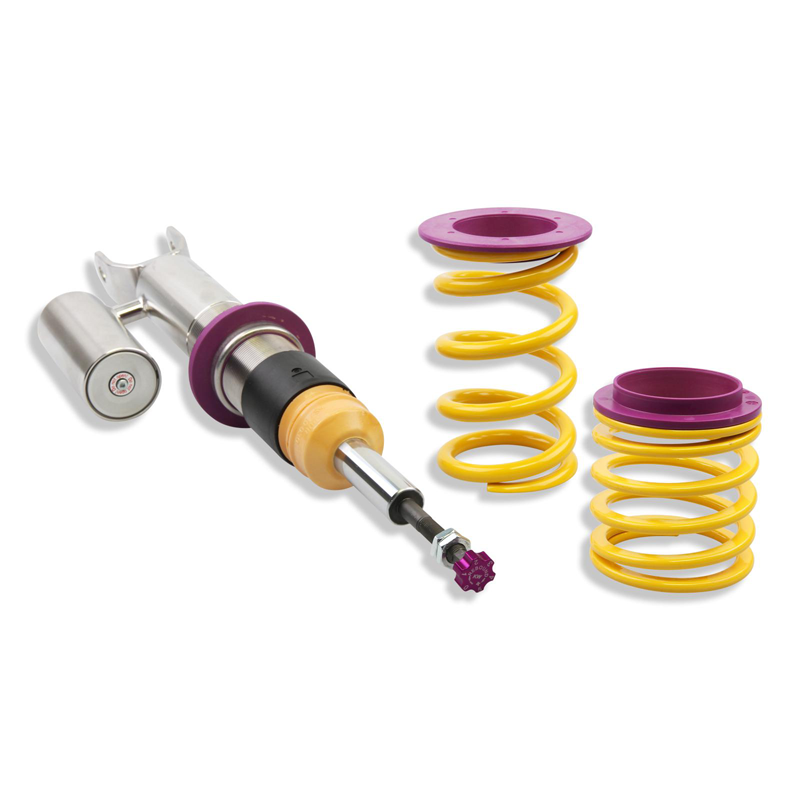KW
KW V3 Coilovers - Porsche 911 (997) GT3/RS & GT2/RS
Lead Time - 3 to 14 days
Couldn't load pickup availability
KW V3s are two-way independently adjustable coilovers that are perfectly suited to everyday use.
KW V3s are the perfect upgrade for your Porsche as they generate far more grip than the standard Porsche components. More grip means your Porsche is more fun to drive and safer too, as KW suspension improves traction in bad weather conditions.
KW V3 coilovers are 2-way independently adjustable (compression and rebound) which allows you to alter the bump and rebound characteristics of the dampers. Using this adjustability you
The higher quality springs, dampers and valving of the KW V3 help to improve ride comfort too. This can be by altering the bump and rebound characteristics of dampers. Your Porsche can also be made more suitable for track driving by tweaking the damper settings.
KW V3s are fully ride-height adjustable, so you can set a ride height of your choosing. Ride height-adjustability means you can improve the dynamics of your Porsche, an example of this would be introducing rake angle into the chassis which improves braking stability and helps to reduce understeer. You can also corner-weight your Porsche thanks to the ride-height adjustment collars.
Technical highlights of the KW V3 Coilovers for Porsche 911 (997) GT3/RS & GT2/RS are:
- 2-Way independently adjustable (16 clicks of rebound, 12 clicks of bump)
- Fully ride-height adjustable
- Stainless steel "inox-line" construction for improved corrosion resistance
- Developed at the Nürburgring
- Compatible with original Porsche top mounts
More information
Every single KW damper uses KW's twin-tube damper technology. Inside each KW damper there are two tubes - the inner tube, which contains the piston and the majority of the damping fluid, and the outer tube which surrounds the inner tube and works as a reservoir for the damping fluid. The outer tube helps to maintain consistent damper performance.
When driving over a bump or undulation, the damper enters the compression phase. As the bump is driven over, the spring on the coilover is compressed. Kinetic energy is generated and accumulated in the spring.
During the compression stroke, the piston rod displaces the oil in the inner tube, which passes through the compression valve located at the bottom of the inner tube. The flow resistance at the compression valve generates the compression damping force. This flow resistance causes the speed of the compression stroke to slow down.
During this process, some of the oil beneath the compressing piston flows upwards through the check valve at low resistance, filling the inner tube behind the piston with oil, ensuring consistent performance.
During the rebound stroke, kinetic energy accumulated in the spring is transformed into heat energy internally as the damper rebounds. The speed at which this happens is controlled by the flow resistance of the rebound valve.
As the piston rebounds the oil above the piston inside the inner tube flows through the holes in the rebound valve. The resistance offered by this valve controls the rebound velocity.
Whilst this is happening, oil stored in the outer tube flows back into the inner tube via the check valve.
The compression and rebound phases are complete and the high-quality KW damper helps keep the wheel in contact with the tarmac and under control at all times.
TVR-A explained
TVR-A stands for Twin Valve Rebound - Adjustable. The technology works at both at both high and low damper speeds. When a bump is encountered at low speed, such as during every day driving or commuting, the internal damper fluid flows at a low volume through an adjustable, conical low-speed bypass. This makes the damper far more supple during day to day use as the damper rebounds more slowly and less harshly than a standard damper.
TVC-A explained
TVC-A stands for Twin Valve Compression - Adjustable. This adjustment controls the cross-section of the low-speed damper valve to allow for more or less compression damping. When a large bump is encountered at high speed, both the needle valve and main valve openly completely to allow for efficient and consistent damper performance. The adjustable compression damping gives you superior vehicle support and control whilst also offering improved comfort versus OEM dampers.
Why choose coilovers?
Car manufacturers often elect to save money when building cars by using cheap and reliable springs and dampers instead of high-quality performance items.
This is where aftermarket coilovers come in. Aftermarket coilover manufacturers use far higher quality materials and more sophisticated technology in their products. The resulting products are of a much higher quality than the springs and dampers that are fitted to your car as standard.
Alongside higher quality materials, the technology used inside aftermarket dampers such as the valving and piston design is far more advanced. Most coilovers are adjustable, allowing you to fine-tune the bump and rebound characteristics of the damper. This gives you full control over the kinematics of your car.
The main advantage of coilovers is in the higher level of grip they create. The higher quality springs and dampers are effective at keeping the tyres in contact with the tarmac even over rough surface, ensuring the tyres are creating as much grip as possible. The tuneable damping settings allow you to reduce body roll; to eliminate nose-diving under heavy braking, and to reduce squat under acceleration.
Coilovers are fully ride-height adjustable. You can adjust the ride height to improve cornering by introducing rake angle, which improves turn-in and increases braking stability. Ride height adjustability allows for a corner-weighting setup to be done, and this greatly improves acceleration, braking and cornering.
Coilovers are a comprehensive suspension performance upgrade, not only in terms of technology and materials but also in terms of the far more in-depth setup possibilities they offer.
























